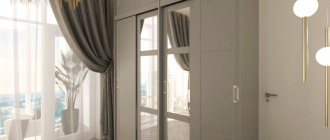The price between floors in new buildings is always different.
And this is common in the secondary market. In the article we will analyze in detail which floor is better to choose in a new building and what you need to pay attention to.
All levels of the building have significant advantages and disadvantages. The floor significantly affects the comfortable life of people.
Many people don’t like the first floor because of the basement below and the possibility of strangers looking into the windows. There are people who only like the lower level because they don't have to climb a lot of steps. Others are afraid to buy a home on the top floor for fear of roof leaks. But there are those who want only the top floor, dreaming of beautiful sunsets and sunrises.
Often, in the construction of new buildings, new technologies are used to improve the comfortable living of each person.
When choosing an apartment in a new building, you need to take into account your personal needs and capabilities:
- floor (high-rise buildings have elevators, but there are situations when they break down. You need to consider whether you can climb up on your own);
- finance (the price for the first floor is the lowest);
- location of the house itself (infrastructure).
Pros and cons of lower levels
About the pros:
- Often in new building projects it is planned to locate offices or retail premises on the first level. And the apartments are located not above the basement, but above these rooms. But in the project format they are still considered the first floor.
- The price of the lower ones is more attractive than that of the upper ones, which is what attracts many.
- Lower-level housing is more often purchased by families with small children, elderly people and people with limited mobility. They cannot depend on the elevator to leave the house.
- In the event of a fire, people on lower floors can evacuate to the street much more easily than residents on upper floors.
- If the first floor is a living space, then the owner has many different possibilities. For example, you can turn a residential space into a non-residential one and organize a small business - a hairdresser, beauty salon, fitness studio and much more.
About the cons:
- Noise from air conditioners in commercial premises and from children's playgrounds. Housing on the 1st and 2nd floors involves not only extraneous noise from the street, but also from the entrance. Especially if there are many people living in the house, you need to be prepared for the constant opening and closing of entrance doors and elevators. The problem can be solved by making good sound insulation of the doors.
- Light. If the windows of the apartment are located on the courtyard side, on the shady side, then almost no natural light will enter the apartment. And more often than usual you will have to use special devices for additional light.
- Safety. Residents of the first floors are always afraid of unauthorized persons entering their apartment through the window. There is a need to install bars on the windows.
- The first floors often do not have balconies or loggias.
- Demand for the first floors is not high. If you want to sell an apartment at a good price, difficulties may arise.
Why shouldn't you buy an apartment on the ground floor?
If you are buying for the purpose of privacy, then in this case it will not work. For the most part, all the first floors are quite noisy. Screams can be heard from children's playgrounds, noise from cars and people simply passing by will not allow you to be in silence. If installing sound insulation is not a problem for you, then you can consider this option.
Why is the first floor bad when buying an apartment?
Neighbors upstairs can create some problems. Since there is still a whole house above you, the likelihood of being flooded is much higher than for others.
A disadvantage may also be that in newer houses the heating system is installed from top to bottom. What does it mean? On the upper floors the water pressure will be better than on the first floors and the same applies to the heating supply. Therefore, apartment owners often have problems with water supply and indoor heat during the winter season.
Most sold - from third to seventh
Floors from 3 to 7 are considered the most popular.
About the pros:
- Natural light penetrates into the apartment if it is not on the shady side.
- Any extraneous sounds from the street are no longer so clearly audible.
- If the elevator is turned off, it will not be inconvenient to climb the stairs.
About the cons:
- If the elevator is broken, you can easily climb up to 3-4 floors, even with a small child or a small number of bags. And to higher floors, it will be much more difficult to overcome many steps with heavy hands.
- Noise cannot be avoided. In the first years of moving in, any house undergoes active renovation work, the noise from which can spoil the mood for more than one month. On middle floors, audibility is higher, since renovation work may surround your apartment on all sides.
Things don't go according to plan
It happens that the owner sells housing in an old building, for example, in a Khrushchev-era building, and buys another apartment in a new building, hoping for an increase in its value in the future. However, it does not have specific goals. He just wants to make money, and exactly how much doesn’t matter.
This is fundamentally wrong. Having no idea about the potential profitability, such a transaction can generally leave you in the red (if, for example, the Khrushchev building is included in the renovation program, when relocating the owner will be given an apartment in a new building, with new renovations, and even a larger area).
Rosenfeld recommends always calculating your return: how much you want to invest in real estate and how much you want to earn.
The expert advises using the real inflation indicator when calculating profitability. The easiest way is to convert the purchase and rental costs into dollars. “Beginner investors often calculate price changes in rubles, but they forget that due to real inflation, the ruble has become much cheaper,” he explains.
Didn't come in the right size. What threatens the population with the boom of small apartments Read more
Upper floors
The upper level is considered from the eighth floor and above.
About the pros:
- because of the beautiful view from the window;
- lots of natural light;
- the air is cleaner.
If you want more natural light, then experts recommend choosing apartments with an open plan and large windows.
In apartments on the top floors, the big advantage is the absence of neighbors above and the opportunity to create a second attic level for the apartment.
About the cons:
- Elevator. If the elevator is broken, going to the upper floors will bring a lot of inconvenience.
- Waiting for the elevator. This will be especially obvious in the morning. But in new buildings they solve this problem by installing several high-speed elevators. And this makes life much easier for the upper levels.
- Fear of heights. There are people who may simply be afraid of heights and categorically refuse to live on the top floors.
- In case of fire, evacuation takes longer.
Corner apartments
In addition to standard-layout apartments, there are also corner options, which are located at the end of the building. A number of buyers have systemic prejudices against them, which do not play a role in the context of modern construction. Today, the benefits of purchasing a corner apartment are as follows:
- Low cost - due to low demand in the housing market.
- Natural light - placing the walls at an angle allows you to increase the total light area. This promotes a healthy indoor climate. In addition, additional window openings make it possible to diversify the views.
- Good thermal insulation - brick walls promote natural air conditioning of the room. Due to their thickness, they are able to effectively retain heat in winter and keep cool in summer.
- The specifics of the location - people who live in such apartments, as a rule, have fewer neighbors and problems with utilities.
Experts' opinion
A person decides for himself on which floor it would be better for him to live. And he selects an apartment both by price and comfort. But there is an opinion of experts who recommend following certain points when choosing:
- Often the first floors of new buildings are now planned for commercial use. Thus, residential premises will start only from the second floor, but will still be cheaper than other floors;
- in the event of an emergency, apartments no higher than the third floor are evacuated faster;
- Middle floor housing is very popular. There are also disadvantages, but the advantages significantly outweigh the advantages of the first floors.
- For romantics and creative people, the top floors of new buildings with large number of floors will be a priority. Enchanting sunsets and alluring calculations will inspire anyone. But it is worth remembering that elevators can break down and therefore cause inconvenience.
Investing in real estate is not the most profitable option
Over the past year and a half in Moscow, rents have increased by only 4%, according to CIAN data. During the same period, apartment prices increased by 22%.
“Even under these conditions, the ratio of rental housing to its cost (in Moscow) is approximately 1 to 200, which gives 5–6% annual yield in rubles. Moreover, changes in the cost of housing, repair costs, the risk of downtime, etc. are not taken into account. That is, the profitability is more than modest. In addition, it is not guaranteed, and in terms of its performance it is inferior even to some federal loan bonds (OFZ),” says the expert.
Let's consider today's situation. On August 10, the Central Bank of the Russian Federation raised the key rate by another 0.25 percentage points, from 6.5% to 6.75%. This is the fifth increase in a row. Last time (in July), the regulator raised the rate by 1 percentage point at once, and this was the most decisive step since 2014.
Following the key rate, mortgage interest rates will rise and, Rosenfeld admits, demand for real estate will decrease. “It is quite possible that these changes will cause problems for developers. On the one hand, they will most likely be faced with a decrease in demand, and on the other hand, with a continuing increase in the cost of building materials and labor,” the expert argues.
Add to this the chronic decline in real disposable income of the population and the accelerating rate of growth in consumer prices. The demand for real estate will decrease and it will not be easy to resell an apartment purchased at the peak of prices.
“Despite the great popularity of real estate investments, they should not be considered profitable by default. It is necessary to pay attention not only to the price level and rental costs, but also to the relationship between supply and demand for rentals. If supply exceeds demand, the investor will have to reduce the rent to attract tenants. In addition, the statistics of real estate profitability in the past does not mean at all that this will be the case in the future. Before investing your money, you should carefully study the market and its features, weigh the pros and cons, and only then make a decision,” he advises.
New building or resale: which house is better to buy and rent an apartment in? More details
Residential floor and health
Living in an urban environment affects the health of residents differently. The quality of life, as well as the degree of negative influence of “urban” factors on the human body, directly depend on the urban environment of the house - village, town, urban landscape (city of a million people, or metropolis).
The higher the apartment, the lower the atmospheric pressure in it. With every 10.5 m of height, the pressure drop is of the order of a millimeter of mercury, i.e. on the 17th floor the atmospheric pressure will be 4.5 mm lower (more rarefied) than on the first level of the high-rise building. For people with an increased risk of stroke or heart attack, living above the 5th floor is not recommended.
However, in the metropolis, residents of floors below the sixth in apartment buildings are influenced by street noise, gassy and dusty atmosphere. Therefore, the best options for apartments on the lower floors are near large bodies of water, park complexes and far from intensive highways.
The upper levels of multi-story high-rise buildings (23-25 floors) under strong wind and temperature loads can deviate from the central axis by 150 mm in both directions. Physically, these vibration vibrations are not felt by residents, but they affect the human nervous system, contributing to stress.











